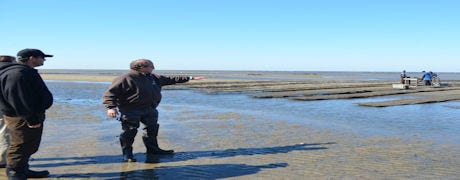October 1, 2012

Things are looking up in New Jersey for the lowly oyster. The regulatory permitting program established six years ago, had been roadblocked by onerous permit requirements set by the state's Department of Environmental Protection.
That roadblock was recently busted by a joint effort of the DEP's Bureau of Shellfisheries and the New Jersey Shellfisheries Council. Four Aquaculture Development Zones were established six years ago. But until this year, only one ADZ had been under development.

ADZ SEEDING: Secretary Fisher (left) points to shellfish workers wading in the New Jersey's coastal Aquaculture Development Zone 4.
The breakthrough came as a joint effort of the New Jersey Departments of Agriculture and DEP. "An increase in aquaculture production will mean more jobs and more revenue for the state," says state Ag Secretary Douglas Fisher.
"DEP has been working hand-in-hand with the Department of Agriculture to apply common sense strategies to improve the Delaware Bay oyster industry, which generates some $20 million for the bay region's economy," DEP Commissioner Bob Martin said. "Advancing the economic viability of these Aquaculture Development Zones will help protect this industry and enhance ecological protection of the Delaware Bay."
What ADZs can grow
Oysters and seaweeds called macroalgaes are commercially valuable commodities that can be grown in ADZs. Oyster bars are seeing a resurgence in the American culinary scene.
ADZ-4, along the Cape Shore, expands oyster production techniques that produce gourmet oysters for the half-shell raw bar market. Twelve individuals are currently in production there.
"What's being produced in Aquaculture Development Zones from our coastal waters can be marketed as a local product with the Jersey Seafood logo, much like Jersey Fresh for our farmers' produce," notes Fisher."By identifying these products in the marketplace, they can meet the demand by consumers for local products."
ADZ-4, alone, could double New Jersey's aquaculture production value of $6.6 million over the next two years. Rutgers University Haskin Shellfish Research Laboratory's Aquaculture Innovation Center in Cape May is producing seed that'll be able to accommodate the seed requirements for oyster growers in the zones.
Approximately 107 10-acre lots available on a first-come, first-served basis with the Bureau of Shellfisheries. ADZ-2 and ADZ-3 are located offshore in the lower Delaware Bay, about three miles from Eat Point and Middle Township.These sites are prime locations for shellfish and macroalgae cultivation.
The Department of Agriculture is working with Rutgers and Stockton College to evaluate potential to produce macroalgaes at these offshore sites. Macroalgaes, the second largest aquaculture sector in the world, have a variety of uses, including industrial, pharmaceutical and food production.
Interested in learning more about these aquaculture opportunities? Call NJDA Aquaculture Specialist Joseph Myers at 609-984-2502 or e-mail him at [email protected].
You May Also Like




